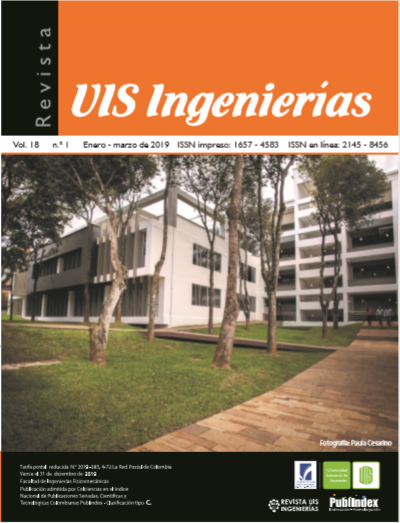Characterization by Scanning Electron Microscopy of the "Electroless Nickel" coating on difusion-borided iron parts
Published 2019-01-01
Keywords
- electroless coating,
- boronizing,
- intermetallic compound,
- diffusion
How to Cite
Abstract
T
The present study is a first approach to determine the feasibility of using the "Electroless Nickel" coating as an option for the anticorrosive reinforcement of borided parts, which may present micro-cracks during normal use. For this study, is the presence of diffusion of the coating in the intermetallic compound was evaluated. We used industrial samples of borided carbon steel J55 pipe according to EndurAlloyMR process (by Endurance Technologies Inc., Calgary, Canada). The test pieces were cleaned, pickled, coated and heat-treated. The morphological characterization was carried out by Scanning Electron Microscopy (SEM). The elemental distribution in the contact zone between the coating and the intermetallic compound was determined using the EDX - Mapping technique and the diffusion area was determined using the EDX - LineScan technique. The results obtained in the elemental analysis allowed to verify the existence of a diffusion zone between the coating and the intermetallic compound of approximately 5-μm thickness, which translates into an excellent adhesion property, increasing the probability of covering the micro-cracks and preserving the anticorrosive protection of borided parts.
Downloads
References
A. Brenner y G.E. Riddell, “Nickel Plating on Steel by Chemical Reduction,” Journal of Research of the National Bureau of Standards, vol. 37, pp. 31-34, 1946.
H.J. West, “Electroless Nickel Barrel Plating,” Metal Finishing, vol. 52, no. 3, pp. 64, 1954.
H.J. West, “Electroless Nickel Plating on Nonferrous Metals,” Metal Finishing, vol. 52, no.7, pp. 72, 1954.
A.H. Graham, R.W. Lindsay y H.J. Read,”The Structure and Mechanical Properties of Electroless Nickel,” Journal of the Electrochemical Society, vol. 112, no. 4, pp. 401-413, 1965.
K.S. Rajam, I. Rajagopal, S.R. Rajagopalan y B. Viswanathan. “DSC, X-ray and magnetic studies on electroless Ni-P films grown in alkaline ethanolamine baths,” Materials Chemistry and Physics, vol. 33, pp. 289-297, 1993.
U.I. Apachitei y J. Duszczyk, “Autocatalytic nickel coatings on aluminium with improved abrasive wear resistance,” Surface and Coatings Technology, vol. 132, pp. 89-98, 2000.
S.B. Antonelli, T.L. Allen, D.C. Johnson y V.M. Dubin, “Crystallization Behavior of Ni–P Alloy Films on Co and Cu Seed Layers,” Journal of The Electrochemical Society, vol. 152, no. 9, pp. J120-J124, 2005.
R.C. Agarwala, S.Z. Ray, “Variation of structure in electroless Ni-P films with phosphorous content,” Zeitschrift fuer Metallkunde/Materials Research and Advanced Techniques, vol. 79, no. 7, pp. 472-475, 1988.
[10] K. G. Keong, W. Sha, y S. Malinov, “Crystallisation kinetics and phase transformation behaviour of electroless nickel–phosphorus deposits with high phosphorus content,” J. Alloys Compd., vol. 334, no. 1, pp. 192–199, 2002. doi: 10.1016/S0925-8388(01)01798-4
J. N. Balaraju, S. M. Jahan, A. Jain, y K. S. Rajam, “Structure and phase transformation behavior of electroless Ni–P alloys containing tin and tungsten,” J. Alloys Compd., vol. 436, no. 1–2, pp. 319–327, 2007. doi: 10.1016/j.jallcom.2006.07.045
J.R. Henry, “Electroless (autocatalytic) plating,” Metal Finishing, vol. 97, no. 1, pp. 431-442, 1999. doi: 10.1016/S0026-0576(01)85302-2
X. Fan, L. Gu, S. Zeng, L. Zhu, C. Wang, Y. Wang y X. Cao, “Improving stability of thermal barrier coatings on magnesium alloy with electroless plated Ni–P interlayer,” Surf. Coatings Technol., vol. 206, no. 21, pp. 4471–4480, 2012. doi: 10.1016/j.surfcoat.2012.05.004
D. Seifzadeh, K. Mohsenabadi, Z. Rajabalizadeh, “Electroless Ni-P plating on magnesium alloy by innovative, simple and non-toxic oxalate pretreatment and its corrosion protection,” RSC Advances, vol. 6, no. 99, pp. 97241-97252, 2016. doi:
10.1039/C6RA19984D
I. Baskaran, S. Narayanan y A. Stephen, “Effect of accelerators and stabilizers on the formation and characteristics of electroless Ni–P deposits,” Materials chemistry and physics, vol. 99, no. 1, pp. 117-126, 2006. doi: 10.1016/j.matchemphys.2005.10.001
M. G. Krukovich, B. A. Prusakov y I. G. Sizov, Plasticity of boronized layers. Switzerland: Springer International, 2016.
A. Vadasz. “Technical considerations for implementing enduralloy hardened production tubing in an oil producing area,” in Panamerican Mature Fields Congress, Veracruz, Mexico, 2015, pp. 15- 159.
E. E. Cárdenas et al. “Characterization and wear performance of boride phases over tool steel substrates”, Adv. Mech. Eng., vol. 8, no. 2, 2016. doi: 10.1177/1687814016630257
K. G. Anthymidis et al. “Boriding of nickel in a fluidized bed reactor,” Materials Research Bulletin, vol. 37, no. 3, pp. 515-522, 2002. doi: 10.1016/S0025-5408(02)00672-4
G. L. Zhunkovskii, B. S. Navrotskii, y Y. P. Kolosvetov, “Boronizing of cobalt and some cobalt base alloys,” Sov. Powder Metall. Met. Ceram., vol. 11, no. 11, pp. 888–890, 1972. doi: 10.1007/BF00806648
K. G. Anthymidis, D. N. Tsipas y E. Stergioudis. “Boriding of titanium alloys in a fluidized bed reactor,” Journal of materials science letters, vol. 20, no. 22, pp. 2067-2069, 2001.
D. N. Tsipas y J. Rus, “Boronizing of alloy steels,” J. Mater. Sci. Lett., vol. 6, no. 1, pp. 118–120, 1987. doi: 10.1007/BF01729451
T. W. Spence y M. M. Makhlouf, “Characterization of the operative mechanism in potassium fluoborate activated pack boriding of steels,” Journal of materials processing technology, vol. 168, no. 1, pp. 127-136, 2005. doi: 10.1016/j.jmatprotec.2004.10.015
P. A. Dearnley y T. Bell, “Engineering the surface with boron based materials,” Surface Engineering, vol. 1, no. 3, pp. 203-217, 1985. doi: 10.1179/sur.1985.1.3.203
A. Küper, X. Qiao, H. R. Stock y P. Mayr, “A novel approach to gas boronizing,” Surface and Coatings Technology, vol. 130, no. 1, pp. 87-94, 2000. doi: 10.1016/S0257-8972(00)00682-4
N. Makuch, M. Kulka y M. Popławski, “Two-stage gas boriding of Nisil in N2–H2–BCl3 atmosphere,” Surface and Coatings Technology, vol. 244, pp. 78-86, 2014. doi: 10.1016/j.surfcoat.2014.01.057
Standard Specification for Electroplated Engineering Nickel Coatings, ASTM B689, 2003.

